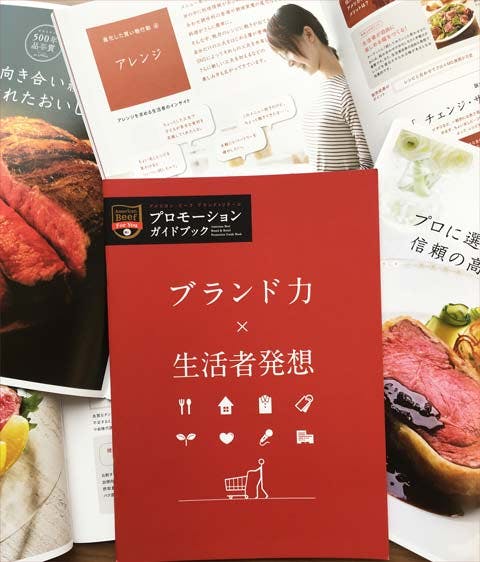New American Beef Promotion Guidebook Focuses on Japanese Consumers
Nearly 200 Japanese retailers, meat processors, distributors and foodservice managers attended a seminar in Tokyo that formally introduced the new USMEF American Beef Promotion Guidebook. The seminar, held at Hotel Okura, was funded by the USDA Market Access Program, the Beef Checkoff Program and the Pork Checkoff.
An electronic version of the guidebook can be found here.

The new USMEF American Beef Promotion Guidebook, which offers suggestions for Japanese retailers to reach consumers, was introduced recently in Tokyo
Chairman Roel Andriessen discussed USMEF’s efforts and successes in Japan to increase demand for U.S. red meat
USMEF Chairman Roel Andriessen opened the event by noting how hard USMEF has worked over the past four decades to connect the U.S. red meat industry and the Japan market. The ability to accurately understand the needs of Japanese consumers has been a key factor in making that connection, which has resulted in increased demand for U.S. red meat products and helped solidify Japan as the largest value destination for U.S. beef and pork.
The guidebook, a greatly expanded version of one first published in 2001, is a perfect example of using education and information to promote U.S. products, Andriessen explained. The initial version advised retailers how to merchandise U.S. beef products and attract the attention of health-conscious consumers. The new guidebook includes that information along with advice on targeting families with two working adults, people cooking special holiday meals, women who are pregnant and other specific consumer groups. USMEF also makes suggestions for consumer-oriented merchandising – looking closely at Japanese lifestyles and potential needs and offering effective meal solutions that utilize more U.S. beef.
“As Japanese consumers’ lifestyles and needs have varied for over a decade or so, USMEF realized the necessity of expanding the guidebook and tailoring it to better meet these trends,” said Takemichi Yamashoji, USMEF director in Japan. “For example, based on detailed analyzes of consumers’ shopping patterns and purposes, the new guidebook offers suggestions to retailers on how to promote U.S. beef as branded items and unique merchandising ideas not used before.”
At the seminar, Yasushi Yamamoto, of Hakuhodo Shopper Marketing Research Center, dove further into the rapid and complicated changes taking place in Japan – and how things like a rise in working couples, improvements in cooking equipment and an array of “easy cooking” seasonings and dishes affect the marketplace. He pointed out that Japanese consumers, much like Americans, become exhausted with shopping because of an overload of information on television and the internet.
Yamamoto introduced countermeasures to attract these “oversaturated” consumers by grasping their unconscious needs and conducting effective promotions with meal solutions.
Along with introducing the new guidebook during the seminar, Yamashoji and USMEF staff presented an overview of U.S. beef and pork production and explained USMEF’s beef and pork marketing strategies for 2016. Promotions such as the Urban BBQ Campaign, appearances by the U.S. pork character Gochipo and upcoming marketing events were detailed.
As a way to further promote U.S. beef at the seminar, recipes discussed were prepared and served to the attendees at a tasting session.
Andriessen and the USMEF-Japan staff acknowledged the contributions to the U.S. red meat industry by David Miller, minister-counselor for agricultural affairs at the U.S. Embassy in Tokyo, who was in attendance. Miller’s third tour in Japan ended this summer and he was planning a return to the U.S. shortly after the USMEF seminar.
